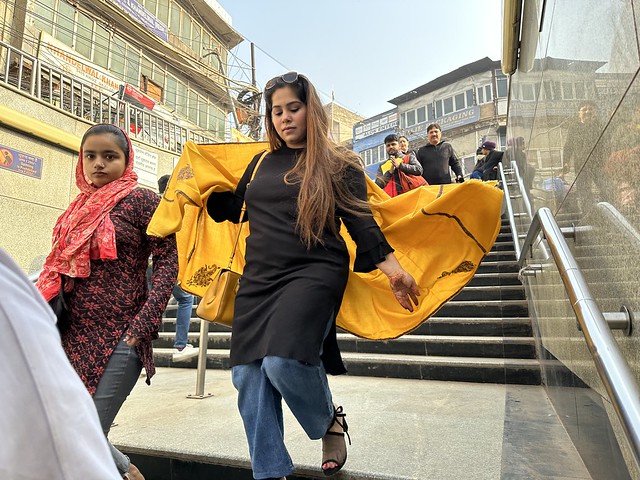
Delhi Metro – Woman’s Commute, Chawri Bazar Metro Station

On the 20th anniversary of Delhi Metro.
[Text and photo by Mayank Austen Soofi]
A young woman in Old Delhi, or Delhi 6, steps out of her house, with a large stole or dupatta purposely hiding the dress beneath. She walks along a congested street, or perhaps she sits in a rickshaw. She reaches the underground station at Chawri Bazar, boards the Yellow Line Metro, and some time later, the same woman emerges from the escalators, into the openness of New Delhi, but without the stole.
A somewhat similar scene appeared in the 2009 movie Delhi-6, in the song Masakali, as if to suggest a degree of freedom that can be experienced by a woman outside the limits of her Old Delhi. Is it merely a Metro legend, or does it actually happen?
One recent afternoon, The Delhi Walla spent an hour at one of the entrances of Chawri Bazar station, the area’s first underground subway destination. Many women strode down the winding staircase, most of them in outfits that would be considered modern everywhere. A young woman came out from under the station— in jeans, and covered in an extra-large stole. She confirmed that the legend was true but politely declined to be snapped.
But the jeans-clad Yumna Alvi agrees to openly record this truth (pictured in the same station). A home-maker in Lakshmi Nagar, separated from Old Delhi by a river, she spent all her years at parents’ home near the Jama Masjid until her marriage some years ago. “Many of us Purani Dilli girls cover ourselves with a chaadar on our way to the Metro.” On reaching the station, she says, the girls remove the covering and cram it into their handbag. It is re-worn on the journey back, while getting out of the same station. “This is a routine,” Yumna says, adding that her college-going cousin Alika, on exiting her Walled City home, always wears a “western dress” but with a burqa over it, which she takes off while entering the station.
“The Old Delhi girls, not all certainly, do this because of the traditions of the place,” Yumna says. “Women who live there are expected to dress up very conservatively. If I happen to be out in jeans and top, but minus the chaadar or shawl, I can sense many eyes on me,” she explains. “That gaze is not always vulgar… it is just that people are not used to seeing local women in other kinds of clothes, they become curious.”
And now Yumna tells what happens once the woman has removed the covering and enters the Metro coach. “We become part of the New Delhi crowd.”

Recent Comments